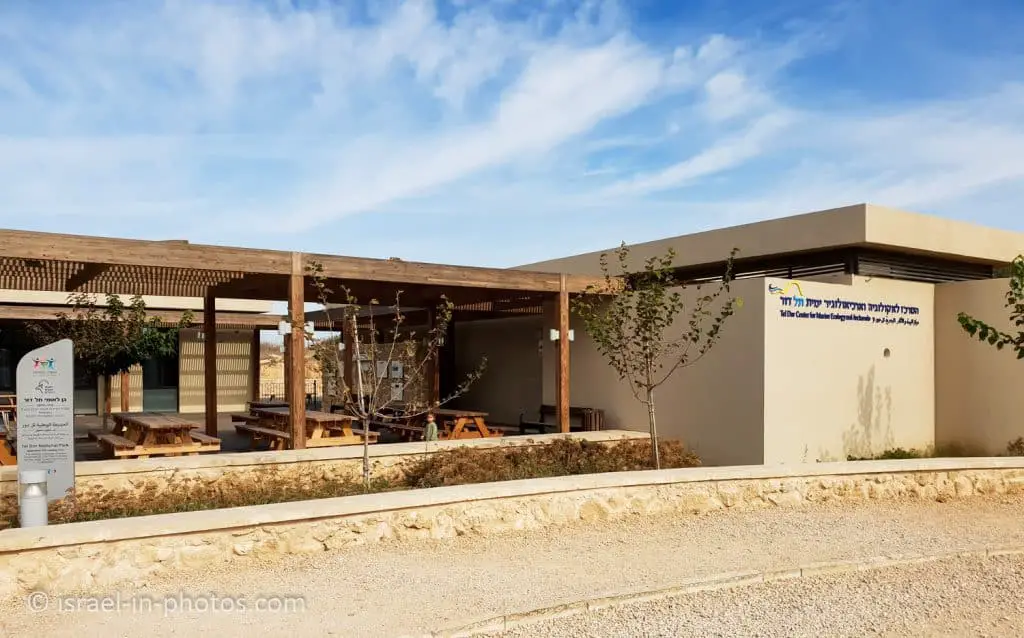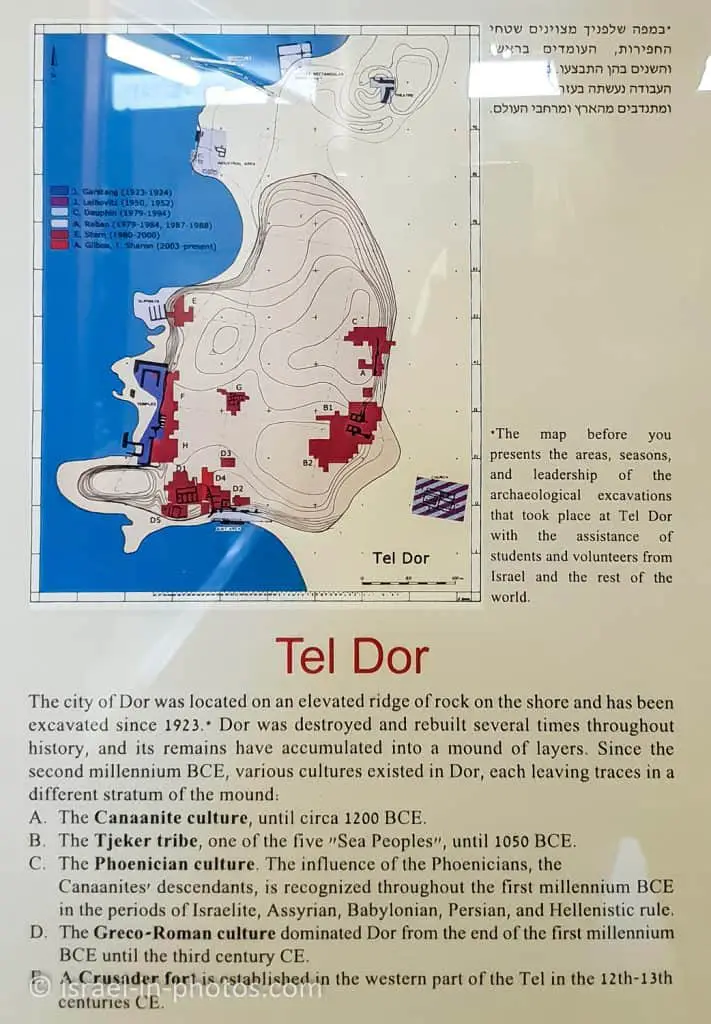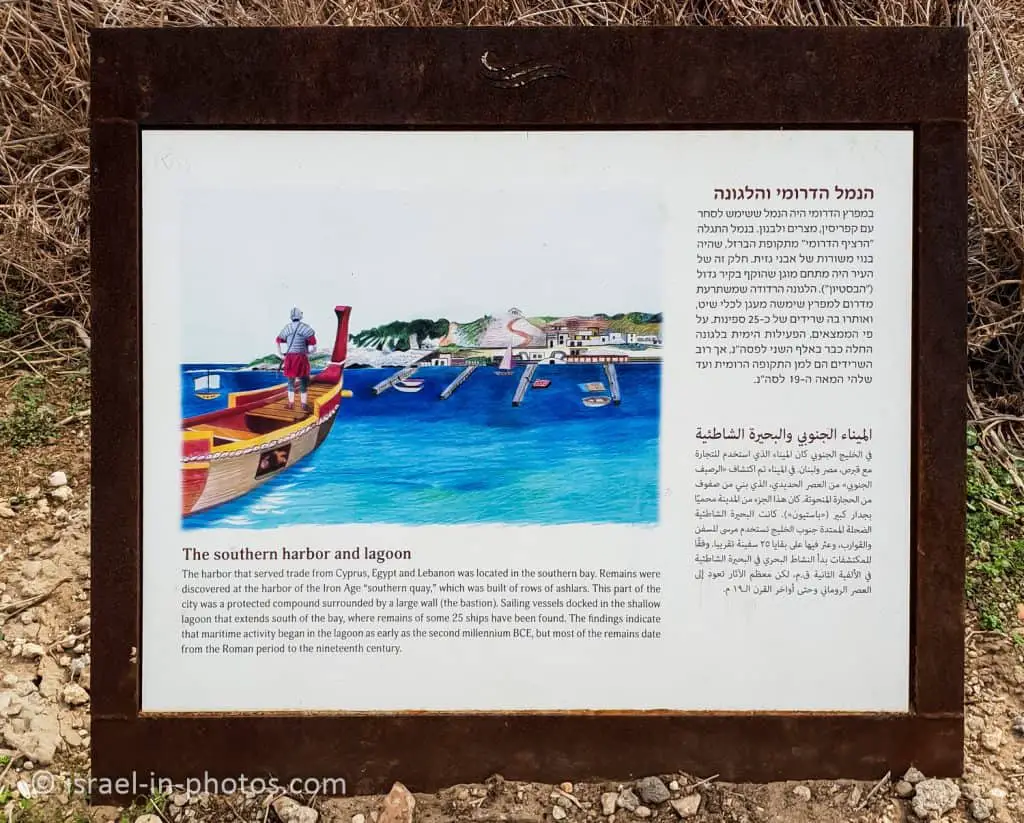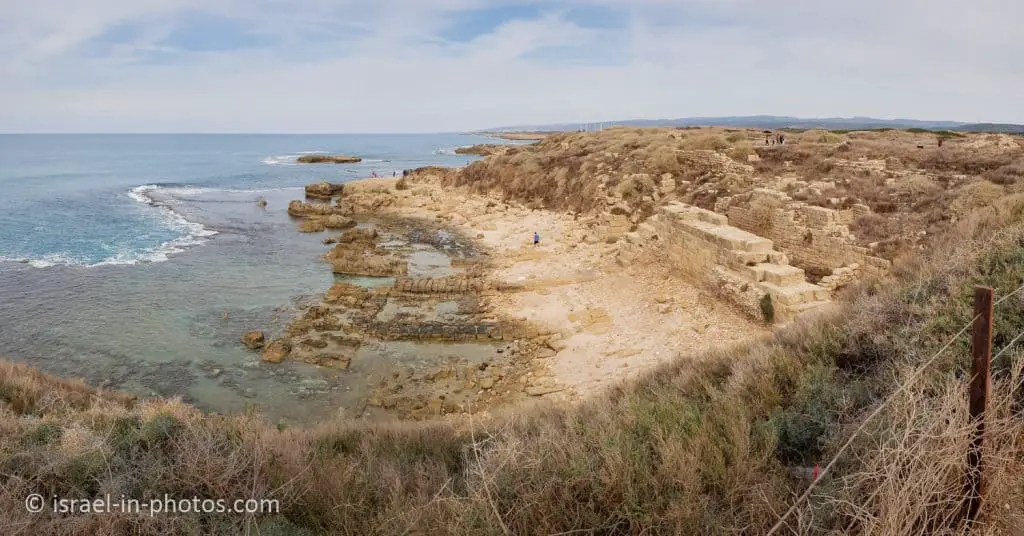Tel Dor National Park – Visitors Guide (Map, Trails, and More)
Tel Dor National Park, located approximately 30 km south of Haifa, features the remains of the ancient city of Dor, situated near the sea.
Table of Contents
Map
Tel Dor National Park is situated near the modern cities of Dor and Nahsholim. It is approximately 30 km south of Haifa. The easiest way to reach this spot is to enter its name into Waze or click this link.
Directions for drivers: Link to Waze and Link to Google Maps
Directions for public transport: Link to Moovit
Interactive map of the area:
And here is a map of Tel Dor National Park:
Note: You can also find an excavation map of Tel Dor below.
Trails
Following the directions, you will arrive at a free parking lot near the Tel Dor Center for Marine Ecology and Archaeology. There is a trail near the parking. And after about twenty meters, the trail splits. If you take a left, you will follow the ridge path (accessible yellow trail). And if you take the right, you will go along the beach path (red route). You can also combine these trails. That is actually what our guide suggested. Follow the yellow trail till point #6, and return using the red trail.
The distance between points #1 and #6 is about one km. Moreover, you can combine this hike with a visit to the Mizgaga Museum at Nahsholim. The distance between point #6 and the Mizgaga Museum is approximately one km.
Opening Hours
Sunday – Thursday and Saturday: 8:00 – 17:00 (16:00 in winter).
Friday: 8:00 – 16:00 (15:00 in winter).
On holiday eves, usually 8:00 – 13:00.
Note: Since the pandemic, the Israel Nature and Parks Authority has started limiting the number of people in each park. Thus, reservations are recommended through the official site (you can find the link below).
On weekdays, you must book places on the official website. And on Saturdays, reservations are not required (entrance is based on available places).
Entrance Fee
Free.
If you plan to visit multiple national parks, consider purchasing a combo ticket. You can find additional info at National Parks and Nature Reserves.
Note: opening hours and ticket prices were updated in November 2025. In any case, recheck the official site before visiting.
Contact Information
Phone: 04-6035300
Email: yossefu@npa.org.il

Several notes from the signs:
- Swimming is prohibited.
- Fishing is prohibited.
- Do not remain in the park after dark.
- Do not light fires.
Restrooms
The parking lot is near the Center for Marine Ecology and Archeology. And inside this complex, you can find restrooms.


Mizgaga Museum at Nahsholim
At the Mizgaga Museum, you can see archeological remains from this national park, including the Tel Dor mosaic. In this post, I will share some information from the museum. For additional information, visit the Mizgaga Museum.
We visited this national park during Hanukkah 2021. During the holidays, the Israel Antiquities Authority offered free tours at Tel Dor and the nearby Mizgaga Museum in Nahsholim. We joined two tours, and for a better picture, I recommend visiting both places together.
Tel Dor Center for Marine Ecology and Archeology
You can climb to the roof of the Tel Dor Center for Marine Ecology and Archeology. And the rooftop lookout was the first place where the guide took us.

You can get a full view of the surroundings at the rooftop lookout.

There are also explanation signs. Here is what the north sign says:
Dor was situated on the southern border of Phoenicia — the coastal strip extending from northern Syria to the southern coastal plain of Israel. The importance of Dor is attested by an inscription on the coffin of Eshmunazar, king of Sidon (fifth century BCE), which mentions “Dor and Jaffa, the great countries of grain in the Sharon Field.” The road northward along the coast of Carmel was a major thoroughfare in the Hellenistic and Roman periods, connecting Dor to Akko and later, Caesarea to Akko. Milestones from that road have survived, as have paved portions, curbstones, and a divider that split the road into two lanes. The road begins about 50 m east of the beach, and subsequently moves about 500 m eastward between two kurkar ridges. Inscribed milestones note that the road was renovated in the second-third centuries CE, but we do not know when it was first built.


Tel Dor is situated on a kurkar (calcareous sandstone) ridge flanked on the west by sandy inlets. Wave erosion of the kurkar and biological buildup on the rock (by creatures that leave behind lime or calcium sediment) have created abrasion platforms where the beach meets the sea. This is the area of high and low tides, also called the littoral zone. The abrasion platforms have three parts:
(1) the supralittoral zone, which receives spray from the waves and where conditions are typically unstable. At low tide in summer, the rocks and the creatures on them are exposed to dryness and high temperatures, and in winter, rainfall washes over them, and their salinity declines;
(2) The littoral zone, which is exposed at low tide and submerged at high tide;
(3) the sublittoral zone, which enjoys stable conditions and where the continuously submerged kurkar rock serves as a habitat for a variety of invertebrates and fish. The lagoon north of Tel Doris is a unique habitat on Israel’s coast.
It is flooded with seawater; but protected from the direct impact of the waves, which creates an area rich in flora and fauna and a preferred reproduction for fish and invertebrates.
Source: sign

To the south, you can see the parking lot. And the signs tell about the Mizgaga Museum.
Ruins of Tel Dor
And now, let’s head to the ruins. There are ruins from various periods, and numerous archaeological excavations have been conducted.

The city of Dor was located on an elevated ridge of rock on the shore and has been excavated since 1923.* Dor was destroyed and rebuilt several times throughout history, and its remains have accumulated into a mound of layers. Since the second millennium BCE, various cultures existed in Dor, each leaving traces in a different stratum of the mound:
A. The Canaanite culture, until circa 1200 BCE.
B. The Tjeker tribe, one of the five “Sea Peoples”, until 1050 BCE.
C. The Phoenician culture. The influence of the Phoenicians, the Canaanites, descendants, is recognized throughout the First millennium BCE in the periods of Israelite, Assyrian, Babylonian, Persian, and Hellenistic rule.
D. The Greco-Roman culture dominated Dor from the end of the first millennium BCE until the third century CE.
E. A Crusader fort is established in the western part of the Tel in the 12th-13th centuries CE.
Source: sign
The Theater
Our first stop was the theater (#2 on the map).


The theater was approximately 60 meters in diameter (like the one in Caesarea). But not much survived. Thus, currently, you can only see slopes on the ground.
Purple Dye Industrial Zone
We headed to point #3 from the theater, the purple dye industrial zone.
It is located on the beach. And it is the only point you cannot see from the accessible trail. Thus, we left the yellow trail and headed to the beach.

Fine fabrics in antiquity were colored with a purple dye extracted from sea snails. These creatures have a gland that excretes a yellowish liquid, which, when exposed to light, changes to pink and dark red. Thousands of snails were required to produce a kilo of dye, and therefore such fabrics came to symbolize royalty and religious nobility. The production of purple dye has been associated with the Phoenician cities, including Dor. The pools and other installations on the beach here were used beginning in the Hellenistic period for mariculture. Some were apparently associated with the dye industry.
Source: sign

And here is a sign from The Mizgaga Museum elaborating on the Biblical blue and royal purple.

Light Blue and Purple were the two main colors that were most frequently referred to in various tracts found from ancient times. The beauty of the colors, the fact that they did not fade as well as the difficulty of their production, all led to their great desirability. In Roman Times, the cost of weaving purple-colored cloth was identical to that of gold, attributing great status to those who could afford to wear it. In Judaism, the Biblical Light Blue is part of the commandment to wear tzitzit on the corner of one’s garment (phylacteries). The robes of the High Priest used for ritual purposes were also of Biblical Blue. The tradition of the Biblical Blue and Royal Purple dyeing process was lost long ago which led to many studies conducted over generations by both researchers and rabbis in an attempt to recover the secret once again. This exhibit attempts to reveal some of the secrets of these colors.
Source: sign
And here, you can see the remains of the industrial zone:

At this point, we returned to the yellow path and reached the following viewpoint after several minutes.

Here is a panorama from the viewpoint (the industrial zone is visible to the right).

The Shipyard
After several minutes, we reached the shipyard (#4 on the map).
Three rectangular chambers (4 m wide and 27 m long; 2.5-3 m deep) were hewn in the kurkar that slopes down to the sea. Their location in relation to sea level shows that they were associated with maritime activity in the city of Dor. They may have been storerooms, but it is more likely that they served as a shipyard or dry-dock to repair vessels that docked at the harbor.
Source: sign
You can see the shipyard by the sea in the following photo (there is a metal ship and people around it).


The Temple Compound
Point of interest #5 on the map is the temple compound.
Two adjacent temples were built in the second century CE on the cliff facing the sea: The northern one was rectangular and the southern one was square. Their eastern façade faced the city and their western facade, which was about 180 m wide and 30 m high, could be seen from the sea. Their construction was a technological challenge that required an artificial platform supported by vaults and ashlar walls 2-5 m thick, which rose to a height of 10 m above sea level. The findings indicate that the compound was never completed, and the deity to which it was dedicated is not known.
Source: sign


And since we visited during the holidays, there was a performer on site. In the following photo, he is explaining the Greek theater.


The Southern Harbor and Lagoon
We passed near the following metal sign on our way to the last viewpoint.

The harbor that served trade from Cyprus, Egypt, and Lebanon was located in the southern bay. Remains were discovered at the harbor of the Iron Age “southern quay,” which was built of rows of ashlars. This part of the city was a protected compound surrounded by a large wall (the bastion). Sailing vessels docked in the shallow lagoon that extends south of the bay, where remains of some 25 ships have been found. The findings indicate that maritime activity began in the lagoon as early as the second millennium BCE, but most of the remains date from the Roman period to the nineteenth century.
Source: sign


Here are several other panoramas from the same viewpoint.



As you can see in the photo above, you can continue walking on the beach path. There is even a sign.

Moreover, as I mentioned before, our guide recommended returning using the beach path.

But since we wanted to get in time for the tour at the Mizgaga Museum, we returned using the yellow trail.

Our tour lasted about 75 minutes, and this was our last stop. However, before concluding this post, I would like to mention one more thing.
Tel Dor Mosaic
At the Mizgaga Museum, you can find the Tel Dor mosaic. A unique aspect of this mosaic is that it is not exclusively made from rocks. Glass pieces have also been integrated into it.

The superb fragmentary mask-and-garland mosaic also unearthed in 2000 is the first major example of Hellenistic opus vermiculatum in the region. Unfortunately, it was not found in situ, but had been broken up and tossed into a Roman pit (pit 2) in area Dl on the southwest side of the tel. Given the quality of this mosaic, it is hard to believe that someone destroyed it on a whim. Earthquake damage or urban renewal come to mind as possible explanations, but until the original context of the mosaic is found, no firm conclusions are possible.
The fragments vary in size from small clusters of tesserae to larger sections measuring over 0.40 x 0.30 m. Thanks to the efforts of colleagues from Hebrew University and at the site museum at Nachsholim, the disparate pieces of one mask and the area adjacent have been successfully restored; a fragment of a second mask and a separate geometric zone awaits supplementation from further excavation and restoration. The masks and garlands are almost certainly part of a border frieze; the central emblema, if there was one, has yet to be identified.
The technique represented in these mosaics is true opus vermiculatum, using 3-5 mm2 tesserae in the field in a wide range of reds, blues, and yellows. There is also extensive use of glass in tones of blue and green, characteristic of Hellenistic mosaics.16 To date there is no evidence for the use of lead strips.17The white limestone field is framed at the top and bottom by red bands using larger tesserae up to 4 x 6 mm in size. Most of the tesserae used for this white background and adjacent sections of the floor are rectilinear and laid horizontally. But as they approach the decorated areas they begin to curve and include tiny chips, often only 1mm across, in order to follow the contours of the fruits, flowers, and mask. This technique is particularly clear where the top of the mask approaches the upper red border. The work is set into a bed of fine mortar 0.019 m thick, supported by a heavy backing of coarser mortar.
Summary
Tel Dor National Park is a lovely place. And if you love archeology, history, or nature, it is worth visiting. Moreover, there is an accessible trail, and it is free of charge. Also, be sure to visit the nearby Mizgaga Museum.
This area has many attractions. You can explore them using the interactive map above.
Have you visited Tel Dor National Park? Tell us in the comments below about your experience.
That’s all for today, and I’ll see you on future travels!
Stay Tuned!
Additional Resources
Here are several resources that I created to help travelers:- Trip Planner with Attractions and Itineraries is the page that will help you create your perfect travel route.
- What is the Best Time to visit Israel? To answer this question, we will consider the weather, prices, holidays, festivals, and more.
- Information and Tips for Tourists to Israel will answer the most common questions tourists have about Israel (including safety, passports, weather, currency, tipping, electricity, and much more).
- Israel National Parks and Nature Reserves include a complete list, top ten, map, tickets (Israel Pass, Matmon, combo), and campsites.
- If you are looking for things to do, here are the pages for Jerusalem, Tel Aviv, Haifa, Sea Of Galilee, Akko (Acre), Eilat, Nazareth, Safed (Tzfat), and Makhtesh Ramon.









I volunteered at Tel Dor in 1984. It may have been in that central area labeled “G” in the map. It was at a crossroad where the main road coming in from the city gate was bisected by another street running north. We believed that I was working in what was a glass makers shop since I dug up lots of glass slag and beads. What an excellent experience!
Thank you for your feedback. And yes, I agree, participating in archeological digs and uncovering old secrets is always exciting!